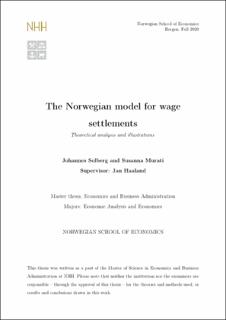The Norwegian model for wage settlements : theoretical analysis and illustrations
Master thesis
Permanent lenke
https://hdl.handle.net/11250/2739800Utgivelsesdato
2020Metadata
Vis full innførselSamlinger
- Master Thesis [4372]
Sammendrag
This study has examined the research question; How can The Norwegian model for wage
settlements be improved using insight from the Ricardo-Viner and Heckscher-Ohlin models?
by formulating hypotheses and illustrating these with data collected from Statistics Norway
(Statistisk sentralbyrå) and the central bank of Norway (Norges Bank). Literature on the
Norwegian model and international trade has existed for a long time, but we have not
found research that applies these theories to the Norwegian model.
The current literature on international trade models has been reviewed and applied to
discuss the findings of this thesis. Supplementing theory from international trade with
knowledge of partial and general equilibria, traded and non-traded sector and intertemporal
trade allowed for additional understanding of the findings.
The findings of this study reveal that there has been a divergence in the capital return and
product prices of traded and non-traded goods and that employment in the non-traded
sector has more than doubled over the last 50 years, while the employment in the traded
sector has been halved during the same time period. This has occurred despite the fact
that the two sectors have mostly experienced the same percentage wage growth.
The theoretical analysis revealed that there has been a problem that the Norwegian model
delays capital transfers and structural change based on the historical development in
Norway. If the development were to change, the biggest problem is that there exists
conflicting interests between the short-term and long-term effects.
Our recommendation is to keep most of the features from the existing Norwegian model,
but that the basis for wage settlements should be expanded. The concern is that the unions
in the manufacturing industry constitute a too narrow basis to determine the wage growth
for the rest of the economy. The current emphasis on the unions in the manufacturing
industry has led to the Norwegian model relying heavily on a partial equilibrium perception.
However, as our results have shown, a general equilibrium perception of wage settlements
is superior. Taking the Norwegian economy as a whole into account in the Norwegian
model should therefore lead to a valuable improvement of the model.
